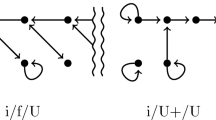Abstract
For an implicit multifunction Φ(p) defined by the generally nonsmooth equation F(x,p)=0, contingent derivative formulas are derived, being similar to the formula Φ′=−F x −1 F p in the standard implicit function theorem for smooth F and Φ. This will be applied to the projection X(p)={x∣∃y: (x,y)∈Φ(p)} of the solution set Φ(p) of the system F(x,y,p)=0 onto the x-space. In particular settings, X(p) may be interpreted as stationary solution sets. We discuss in detail the situation in which X(p) arises from the Karush–Kuhn–Tucker system of a nonlinear program.
Similar content being viewed by others
References
J.–P. Aubin and I. Ekeland, Applied Nonlinear Analysis (Wiley, New York, 1984).
J.–P. Aubin and H. Frankowska, Set–Valued Analysis (Birkhäuser, Boston, 1990).
J.F. Bonnans and A. Shapiro, Optimization problems with perturbations: A guided tour, SIAM Review 40 (1998) 228–264.
J.F. Bonnans and A. Shapiro, Perturbation Analysis of Optimization Problems (Springer, New York, 2000).
A. Dontchev and R.T. Rockafellar, Characterizations of strong regularity for variational inequalities over polyhedral convex sets, SIAM Journal on Optimization 6 (1996) 1087–1105.
A. Dontchev and R.T. Rockafellar, Characterizations of Lipschitz stability in nonlinear programming, in: Mathematical Programming with Data Perturbations, ed. A.V. Fiacco (Marcel Dekker, New York, 1997) pp. 65–82.
A.V. Fiacco, Sensitivity analysis for nonlinear programming using penalty functions, Mathematical Programming 10 (1976) 287–311.
A.V. Fiacco and G.P. McCormick, Nonlinear Programming: Sequential Unconstrained Minimization Techniques (Wiley, New York, 1968).
J. Gauvin and R. Janin, Directional behaviour of optimal solutions in nonlinear mathematical programming, Math. Oper. Res. 13 (1988) 629–649.
D. Klatte, Upper Lipschitz behavior of solutions to perturbed C 1,1 programs, Mathematical Programming 88 (2000) 285–311.
D. Klatte and B. Kummer, Generalized Kojima functions and Lipschitz stability of critical points, Computational Optimization and Applications 13 (1999) 61–85.
M. Kojima, Strongly stable stationary solutions on nonlinear programs, in: Analysis and Computation of Fixed Points, ed. S.M. Robinson (Academic Press, New York, 1980) pp. 93–138.
B. Kummer, Lipschitzian inverse functions, directional derivatives and application in C 1,1–optimization, Journal of Optimization Theory and Applications 70 (1991) 559–580.
B. Kummer, An implicit function theorem for C 0,1–equations and parametric C 1,1–optimization, Journal of Mathematical Analysis and Applications 158 (1991) 35–46.
B. Kummer, Lipschitzian and pseudo–Lipschitzian inverse functions and applications to nonlinear programming, in: Mathematical Programming with Data Perturbations, ed. A.V. Fiacco (Marcel Dekker, New York, 1997) pp. 201–222.
B. Kummer, Metric regularity: Characterizations, nonsmooth variations and successive approximation, Optimization 46 (1999) 247–281.
A.B. Levy, Implicit multifunction theorems for the sensitivity analysis of variational conditions, Mathematical Programming 74 (1996) 333–350.
A.B. Levy and R.T. Rockafellar, Sensitivity analysis of solutions to generalized equations, Transactions of the American Mathematical Society 345 (1994) 661–671.
A.B. Levy and R.T. Rockafellar, Sensitivity analysis of solutions in nonlinear programming, in: Recent Advances in Nonsmooth Optimization, eds. D.–Z. Du, L. Qi and R.S.Womersley (World Scientific, 1995) pp. 215–223.
A.B. Levy and R.T. Rockafellar, Variational conditions and the proto–differentiation of partial subgradient mappings, Nonlinear Analysis: Theory, Methods & Applications 26 (1996) 1951–1964.
J.–S. Pang, A degree–theoretic approach to parametric nonsmooth equations with multivalued perturbed solution sets, Mathematical Programming 62 (1993) 359–383.
R.A. Poliquin and R.T. Rockafellar, Proto–derivative formulas for basic subgradient mappings in mathematical programming, Set–Valued Analysis 2 (1994) 275–290.
D. Ralph and S. Dempe, Directional derivatives of the solution of a parametric nonlinear program, Mathematical Programming 70 (1995) 159–172.
S.M. Robinson, Strongly regular generalized equations, Mathematics of Operations Research 5 (1980) 43–62.
S.M. Robinson, Some continuity properties of polyhedral multifunctions, Mathematical Programming Study 14 (1981) 206–214.
S.M. Robinson, An implicit–function theorem for a class of nonsmooth functions, Mathematics of Operations Research 16 (1991) 292–309.
R.T. Rockafellar and R.J.–B. Wets, Variational Analysis (Springer, Berlin, 1997).
A. Shapiro, Sensitivity analysis of nonlinear programs and differentiability properties of metric projections, SIAM Journal on Control and Optimization 26 (1988) 628–645.
Author information
Authors and Affiliations
Rights and permissions
About this article
Cite this article
Klatte, D., Kummer, B. Contingent Derivatives of Implicit (Multi-) Functions and Stationary Points. Annals of Operations Research 101, 313–331 (2001). https://doi.org/10.1023/A:1010957515360
Issue Date:
DOI: https://doi.org/10.1023/A:1010957515360



